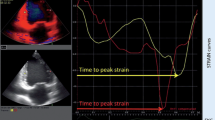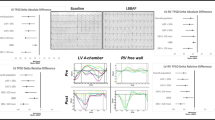Abstract
Background
Interventricular mechanical dyssynchrony (VVMD) is a strong predictor of cardiac resynchronization therapy (CRT) response. However, no simple and reliable clinical method of measuring VVMD during CRT implant is currently available. We tested the hypothesis that the EnSite™ NavX™ system (St. Jude Medical, St. Paul, MN, USA) can be used intraoperatively to determine VVMD, thereby facilitating CRT optimization.
Methods
During CRT implant, the leads in the right atrium (RA), right ventricle (RV), and left ventricle (LV) were connected to the EnSite™ NavX™ system to record the real-time 3D motion of the lead electrodes. The distances from RA to RV lead electrodes (RA–RV) and RA to LV lead electrodes (RA–LV) were computed over ten cardiac cycles during each of RV pacing and biventricular (BiV) pacing, respectively. The degree of synchrony was computed from the distance waveforms between RA–RV and RA–LV by a cross-covariance method to characterize VVMD. Septal-to-posterior wall motion delay (SPWMD) from M-mode echocardiography (echo) was measured for reference at each pacing intervention. VVMD was present in all five patients undergoing CRT implant.
Results
Four of the five patients demonstrated clear improvement in EnSite™ NavX™-derived VVMD during BiV versus RV pacing, which corresponded to the SPWMD results by echo.
Conclusions
It is feasible to characterize VVMD and resynchronization in CRT patients with the EnSite™ NavX™ system during implant, demonstrating its potential as a tool for intraoperative CRT optimization.



Similar content being viewed by others
Abbreviations
- BiV:
-
Biventricular
- CRT:
-
Cardiac resynchronization therapy
- EMSI:
-
EnSite™ Mechanical Synchrony Index
- IEGM:
-
Intracardiac electrograms
- LV:
-
Left ventricle
- RA:
-
Right atrium
- RA–RV:
-
Distance from RA and RV electrodes
- RA–LV:
-
Distance from RA and LV electrodes
- RV:
-
Right ventricle
- RV–LV:
-
Distance from RV and LV electrodes
- SPWMD:
-
Septal-to-posterior wall motion delay
- TDI:
-
Tissue Doppler imaging
- VVMD:
-
Interventricular mechanical dyssynchrony
- XCA:
-
Cross-correlation analysis
References
Abraham, W., Fisher, W. G., Smith, A. L., Delurgio, D. B., Leon, A. R., Loh, E., et al. (2002). Cardiac resynchronization in chronic heart failure. The New England Journal of Medicine, 346, 1845–1853.
Moss, A. J., Hall, W. J., Cannom, D. S., Klein, H., Brown, M. W., Daubert, J. P., et al. (2009). Cardiac-resynchronization therapy for the prevention of heart-failure events. The New England Journal of Medicine, 361(14), 1329–1338.
Dickstein, K., Vardas, P. E., Auricchio, A., Daubert, J. C., Linde, C., McMurray, J., et al. (2010). 2010 focused update of ESC guidelines on device therapy in heart failure: an update of the 2008 ESC guidelines for the diagnosis and treatment of acute and chronic heart failure and the 2007 ESC guidelines for cardiac and resynchronization therapy. European Journal of Heart Failure, 12(11), 1143–1153.
Lozano, I., Bocchiardo, M., Achtelik, M., Gaita, F., Trappe, H. J., Saxon, L., et al. (2000). Impact of biventricular pacing on mortality in a randomized crossover study of patients with heart failure and ventricular arrhythmias. Pacing and Clinical Electrophysiology, 23(11 Pt 2), 1771–1772.
Cleland, J. G., Daubert, J. C., Erdmann, E., Freemantle, N., Gras, D., Kappenberger, L., et al. (2005). The effect of cardiac resynchronization on morbidity and mortality in heart failure. The New England Journal of Medicine, 352, 2539–2549.
Gras, D., Leclercq, C., Tang, A. S., Bucknall, C., Luttikhuis, H. O., & Kristein-Pedersen, A. (2002). Cardiac resynchronization therapy in advanced heart failure: the multicenter Insync clinical study. European Journal of Heart Failure, 4, 311–320.
Young, J. B., Abraham, W. T., Smith, A. L., Leon, A. R., Lieberman, R., Willkoff, B., et al. (2003). Combined cardiac resynchronization and implantable cardioversion defibrillation in advanced chronic heart failure: the MIRACLE ICD trial. JAMA: The Journal of the American Medical Association, 389, 2685–2694.
Linde, C., Braunschweig, F., Gadler, F., Bailleul, C., & Daubert, J. C. (2003). Long-term improvements in quality of life by biventricular pacing in patients with chronic heart failure: results from the Multisite Stimulation in Cardiomyopathy Study (MUSTIC). The American Journal of Cardiology, 91, 1090–1095.
Cazaeu, S., Leclercq, C., Lavergne, T., Walker, S., Verma, C., Linde, C., et al. (2001). Effect of multisite biventricular pacing in patients with heart failure and intraventricular conduction delay. The New England Journal of Medicine, 344, 873–880.
Auricchio, A., Stellbrink, C., Sack, S., Block, M., Vogt, J., Bakker, P., et al. (2002). Long-term clinical effect of hemodynamic optimized cardiac resynchronization therapy in patients with heart failure and ventricular conduction delay. Journal of the American College of Cardiology, 39, 2026–2033.
Bristow, M. R., Saxon, L. A., Boehmer, J., Krueger, S., Kass, D. A., De, M. T., et al. (2004). Cardiac resynchronization therapy with or without an implantable defibrillator in advanced chronic heart failure. The New England Journal of Medicine, 350, 2140–2150.
Sutton, M. G., Plappert, T., Hilpisch, K. E., Abraham, W. T., Hayes, D. L., & Chinchoy, E. (2006). Sustained reverse left ventricular structural remodeling with cardiac resynchronization at one year is a function of etiology: quantitative Doppler echocardiography evidence from Multicenter Insync Randomized Clinical Evaluation (MIRACLE). Circulation, 113, 266–272.
Penicka, M., Bartunek, J., De Bruyne, B., Vanderheyden, M., Goethals, M., De Zutter, M., et al. (2004). Improvement of left ventricular function after cardiac resynchronization therapy is predicted by tissue Doppler imaging echocardiography. Circulation, 109, 978–983.
Ansalone, G., Gainnantoni, P., Ricci, R., Trambaiolo, P., Laurenti, A., & Fedele, F. (2001). Doppler myocardial imaging in patients with heart failure receiving biventricular pacing treatment. American Heart Journal, 142, 881–896.
Yu, C. M., Fun, J. W., Zhang, Q., Chan, C. K., Chan, Y. S., Lin, H., et al. (2004). Tissue Doppler imaging is superior to strain rate imaging and postsystolic shortening on the prediction of reverse remodeling in both ischemic and nonischemic heart failure after cardiac resynchronization therapy. Circulation, 110, 66–73.
Bax, J. J., Marwick, T. H., Molhoek, S. G., Bleeker, G. B., van Erven, L., Boersma, E., et al. (2003). Left ventricular dyssynchrony benefit of cardiac resynchronization therapy in patients with end-stage heart failure before pacemaker implantation. The American Journal of Cardiology, 92, 1238–1240.
Lim, P., Mitchell-Heggs, L., Buakhamsri, A., Thomas, J. D., & Grimm, R. A. (2009). Impact of left ventricular size on tissue Doppler and longitudinal strain by speckle tracking for assessing wall motion and mechanical dyssynchrony in candidates for cardiac resynchronization therapy. Journal of the American Society of Echocardiography, 22, 695–701.
Chung, E. S., Leon, A. R., Tavazzi, L., Sun, J. P., Nihoyannopoulos, P., Merlino, J., et al. (2008). Results of the Predictors of Response to CRT (PROSPECT) trial. Circulation, 117(20), 2608–2616.
Yu, C. M., Fung, W. H., Lin, H., Zhang, Q., Sanderson, J. E., & Lau, C. P. (2002). Predictors of left ventricular reverse remodeling after cardiac resynchronization therapy for heart failure secondary to idiopathic dilated or ischemic cardiomyopathy. The American Journal of Cardiology, 9, 684–688.
Sogaard, P., Egeblad, H., Kim, W. Y., Jensen, H. K., Pedersen, A. K., Kristensen, B. O., et al. (2002). Tissue Doppler imaging predicts improved systolic performance and reversed left ventricular remodeling during long-term cardiac resynchronization therapy. Journal of the American College of Cardiology, 40(4), 723–730.
Suffoletto, M. A., Dohi, K., Cannesson, M., Saba, S., & Gorcsan, J., III. (2006). Novel speckle tracking radial strain from routine black-and-white echocardiographic images to quantify dyssynchrony and predict response to cardiac resynchronization therapy. Circulation, 113, 235–240.
Hawkins, N. M., Petrie, M. C., MacDonald, M. R., Hogg, K. J., & McMurray, J. J. (2006). Selecting patients for cardiac resynchronization therapy: electrical or mechanical? European Heart Journal, 27, 1270–1281.
Capasso, F., Giunta, A., Simone, A. D., Turco, P., Rocca, V. L., Grimaldi, M. G., et al. (2007). Acute left ventricular dyssynchrony improvement predicts long-term benefit from cardiac resynchronization therapy. Pacing and Clinical Electrophysiology, 30(S1), S62–S65.
Instructions for Use, EnSite System 7.0. (2007). St. Jude Medical, St. Paul, MN.
Pitzalis, M. V., Iacoviello, M., Romito, R., Massari, F., Rizzon, B., Luzzi, G., et al. (2002). Cardiac resynchronization therapy tailored by echocardiography evaluation of ventricular asynchrony. Journal of the American College of Cardiology, 40(9), 1615–1622.
Semmlow, J. L. (2009). Biosignal and medical image processing (2nd ed., pp. 39–40). Boca Raton, FL: CRC.
Pan, C., Hoffmann, R., Kühl, H., Severin, E., Franke, A., & Hanrath, P. (2001). Tissue tracking allows rapid and accurate visual evaluation of left ventricular function. European Journal of Echocardiography, 2, 197–202.
Murphy, R. T., Sigurdsson, G., Mulamalla, S., Agler, D., Popovic, Z. B., Starling, R. C., et al. (2006). Tissue synchronization imaging and optimal left ventricular pacing site in cardiac resynchronization therapy. The American Journal of Cardiology, 97, 1615–1621.
Leitman, M., Lysyansky, P., Sidenko, S., Shir, V., Peleg, E., Binenbaum, M., et al. (2004). Two-dimensional strain—a novel software for real-time quantitative echocardiographic assessment of myocardial function. Journal of the American Society of Echocardiography, 17, 1021–1029.
Gorcsan, J., III, & Suffoletto, M. S. (2008). The role of tissue Doppler and strain imaging in predicting response to CRT. Europace, 10(Suppl 3), iii80–iii87.
Ryu, K., D’Avila, A., Heist, E. K., Rosenberg, S. P., Chou, J., Yang, M., et al. (2010). Simultaneous electrical and mechanical mapping using 3D cardiac mapping system: novel approach for optimal cardiac resynchronization therapy. Journal of Cardiovascular Electrophysiology, 21(2), 219–222.
Olsen, N., Mogelvang, R., Jons, C., Fritz-Hansen, T., & Sogaar, P. (2009). Predicting response to cardiac resynchronization therapy with cross-correlation analysis of myocardial systolic acceleration: a new approach to echocardiographic dyssynchrony evaluation. Journal of the American Society of Echocardiography, 22(6), 657–664.
Acknowledgments
This study was supported by a research grant from St. Jude Medical, Inc.
Author information
Authors and Affiliations
Corresponding author
Additional information
Registration information
This study was conducted under the EnSite for Real-Time Cardiac Performance Measurements Study ClinicalTrials.gov Identifier NCT00632450.
Appendix
Appendix
EMSI was computed as follows. Given the recorded 3D positions of the tip electrodes of each respective lead, RA (x 1, y 1, z 1); RV (x 2, y 2, z 2); and LV (x 3, y 3, z 3), the vector between RA and RV, and RA and LV (abbreviated as RA–RV and RA–LV, respectively) was calculated using the following equations:
As described in the text, the average position of the RA electrode over a cardiac cycle is used as a fixed reference point, while the positions of the RV and LV electrodes are functions of time. The distance between the respective electrodes is computed as the magnitude of the vectors.
EMSI, which is the cross-covariance coefficient of the RA–RV and RA–LV waveforms, is calculated by
where c is the cross-covariance correlation, \( x = \left| {\overrightarrow {{\text RA} - {\text RV} } } \right|{, }y = \left| {\overrightarrow {{\text RA} - {\text LV} } } \right| \), N is the length of the RA–RV and RA–LV waveforms, and m = 1, 2,…2 N − 1.
Rights and permissions
About this article
Cite this article
Sperzel, J., Brandt, R., Hou, W. et al. Intraoperative characterization of interventricular mechanical dyssynchrony using electroanatomic mapping system—a feasibility study. J Interv Card Electrophysiol 35, 189–196 (2012). https://doi.org/10.1007/s10840-012-9695-0
Received:
Accepted:
Published:
Issue Date:
DOI: https://doi.org/10.1007/s10840-012-9695-0




